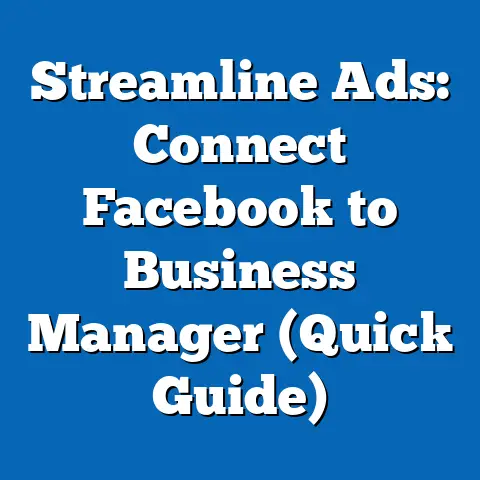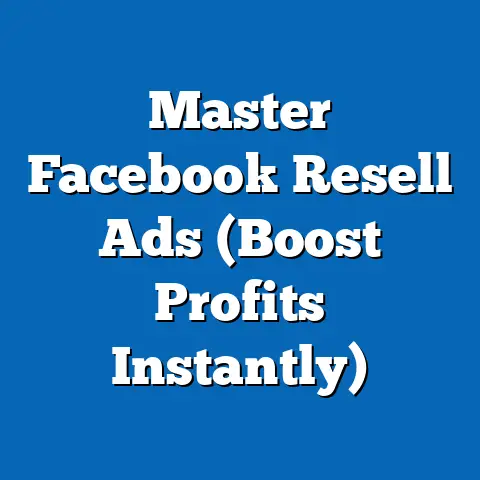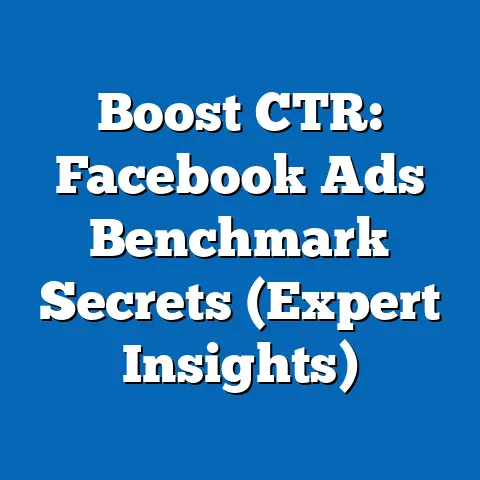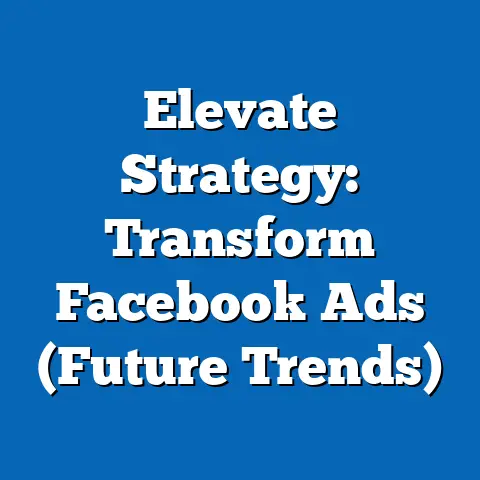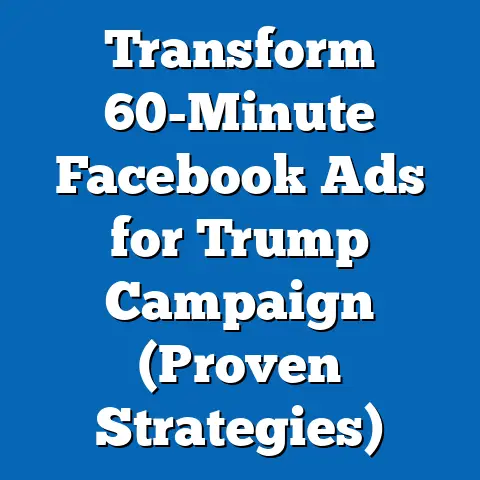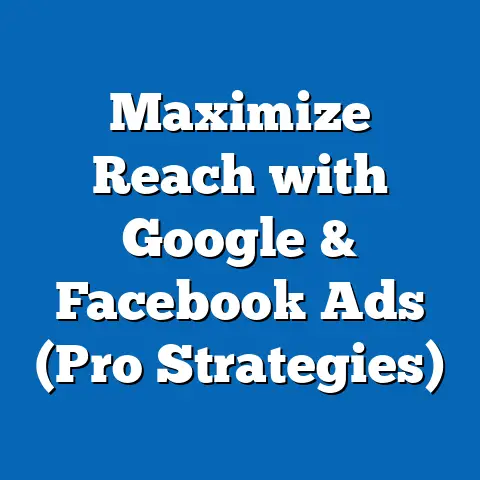Maximize Impact with Facebook Dark Posts (Strategic Insights)
Imagine a bustling e-commerce startup, fueled by creativity and innovation, launching its latest product. As the clock strikes midnight, with the world asleep, their Facebook ad campaign goes live. The ad, a “dark post,” targets specific audiences with precision, ensuring that the right message reaches the right people at the right time. By dawn, the startup’s online store is buzzing with activity, and sales are soaring. This is the power of Facebook dark posts—a tool that enables brands to deliver tailored messages without cluttering their main pages.
In today’s digital landscape, where consumers are bombarded with information, personalized marketing is no longer a luxury – it’s a necessity. Facebook dark posts, also known as unpublished posts, offer a powerful way to achieve this personalization. They allow you to create and test different ad variations without flooding your main Facebook page with promotional content. It’s a nuanced advertising method with the potential to significantly boost your marketing ROI. Let’s dive into the strategic insights that will unlock the full potential of Facebook dark posts for your business.
Section 1: Understanding Facebook Dark Posts
Before we jump into the strategies, let’s establish a solid foundation by understanding what Facebook dark posts actually are.
What are Facebook Dark Posts?
Facebook dark posts, or unpublished posts, are essentially ads that don’t appear on your Facebook page’s timeline. Think of them as stealth marketing tools. Unlike regular posts, which are visible to everyone who follows your page, dark posts are only shown to the specific audience you target through Facebook’s advertising platform.
I remember when I first started using Facebook ads, I was hesitant to post a bunch of different ad variations on my page. It felt cluttered and potentially confusing for my audience. That’s when I discovered the beauty of dark posts. They allowed me to test different messages, visuals, and targeting options without impacting the user experience on my main page.
Dark Posts vs. Traditional Posts and Ads
The key difference lies in visibility and purpose. Traditional posts are designed to engage your existing audience and build brand awareness organically. Facebook ads, on the other hand, are paid promotional messages designed to reach a wider audience based on specific demographics, interests, and behaviors. Dark posts bridge the gap between these two. They leverage the targeting capabilities of ads but allow for more nuanced and controlled messaging than traditional page posts.
Here’s a quick comparison:
- Traditional Posts: Visible on your page, organic reach, good for general updates and community building.
- Facebook Ads: Paid reach, targets specific audiences, good for driving conversions and reaching new customers.
- Dark Posts: Paid reach, targets specific audiences, doesn’t appear on your page, ideal for testing and personalized messaging.
The Technicalities: Creating and Functioning Dark Posts
Creating a dark post is surprisingly straightforward. You’ll primarily work within Facebook Ads Manager, the central hub for all your advertising activities. Here’s a breakdown of the process:
- Access Ads Manager: Navigate to Facebook Ads Manager (business.facebook.com) and select the ad account you want to use.
- Create a Campaign: Click the “Create” button to start a new campaign. Choose your marketing objective (e.g., traffic, engagement, conversions).
- Set Your Audience: Define your target audience based on demographics, interests, behaviors, and custom audiences.
- Choose Placements: Select where you want your ad to appear (e.g., Facebook feed, Instagram feed, Audience Network).
- Create Your Ad: This is where you create your dark post. You can choose from various ad formats and input your text, images, or videos.
- Publish: Once you’re satisfied, publish your ad. It will only be visible to your targeted audience.
The magic happens in step 5. When creating your ad, you have the option to create a new ad from scratch or use an existing post. When you create a new ad from scratch within Ads Manager, it automatically becomes a dark post.
Various Formats of Dark Posts
Facebook offers a variety of ad formats that you can use for your dark posts, each with its own strengths and potential advantages:
- Single Image/Video Ads: These are the most basic ad formats, featuring a single image or video with accompanying text. They’re great for simple, direct messages.
- Carousel Ads: Carousel ads allow you to showcase multiple images or videos in a scrollable format. This is ideal for highlighting different products, features, or aspects of your brand.
- Collection Ads: Collection ads are designed for e-commerce businesses. They feature a main image or video with a selection of related products displayed below.
- Instant Experience Ads (formerly Canvas Ads): These are full-screen, mobile-optimized ads that provide an immersive and interactive experience. They’re great for storytelling and showcasing your brand in a unique way.
- Lead Generation Ads: Lead generation ads are designed to collect leads directly within Facebook. They include a form that users can fill out without leaving the platform.
Choosing the right format depends on your marketing goals and the type of content you want to share. For example, if you’re promoting a new clothing line, a carousel ad might be the best option. If you’re trying to generate leads for a service-based business, a lead generation ad could be more effective.
Key Takeaway: Facebook dark posts are a powerful advertising tool that allows you to target specific audiences with personalized messages without cluttering your main page. Understanding the different formats and how they function within Ads Manager is crucial for success.
Next Step: Familiarize yourself with Facebook Ads Manager and experiment with creating different types of dark posts.
Section 2: The Strategic Advantages of Dark Posts
Now that we have a clear understanding of what dark posts are, let’s explore the strategic advantages they offer to marketers.
Targeting Capabilities and Segmentation
One of the biggest advantages of dark posts is their unparalleled targeting capabilities. Facebook allows you to target your ads based on a wide range of factors, including:
- Demographics: Age, gender, location, education, etc.
- Interests: Hobbies, interests, pages they like, etc.
- Behaviors: Purchase history, online activity, device usage, etc.
- Custom Audiences: Uploaded lists of customers, website visitors, app users, etc.
- Lookalike Audiences: Facebook will find people who are similar to your existing customers.
This granular targeting allows you to create highly personalized messages that resonate with specific segments of your audience. For example, you could create one dark post targeting women aged 25-35 who are interested in fashion, and another dark post targeting men aged 35-45 who are interested in sports.
A/B Testing and Experimentation
Dark posts are perfect for A/B testing. Because they don’t appear on your main page, you can run multiple ad variations simultaneously without confusing your audience. This allows you to test different headlines, images, calls to action, and targeting options to see what performs best.
I’ve personally used dark posts extensively for A/B testing. I remember one campaign where I was promoting a new e-book. I created two dark posts with different headlines:
- Dark Post A: “Download Your Free E-book: The Ultimate Guide to Facebook Advertising”
- Dark Post B: “Unlock the Secrets to Facebook Advertising Success: Get Your Free E-book Now”
After running the ads for a week, I found that Dark Post B had a significantly higher click-through rate. This insight allowed me to optimize my campaign and focus on the headline that resonated most with my target audience.
Improved Engagement and Relevance
By targeting specific audiences with personalized messages, you can significantly improve engagement and relevance. People are more likely to interact with ads that are tailored to their interests and needs. This can lead to higher click-through rates, lower ad costs, and ultimately, better results.
Think about it: Would you rather see a generic ad for a product you’re not interested in, or a personalized ad for a product that directly addresses your needs and interests? The answer is obvious.
Real-World Examples of Success
Many businesses have successfully utilized dark posts to achieve their marketing goals. Here are a few examples:
- E-commerce Business: An online clothing store uses dark posts to target different customer segments with personalized product recommendations. They show ads for dresses to women who have previously purchased dresses and ads for shirts to men who have previously purchased shirts.
- Service-Based Business: A local gym uses dark posts to target people who live near their location and are interested in fitness. They offer a free trial to new members and promote different classes based on individual interests.
- Non-Profit Organization: A charity uses dark posts to raise awareness for their cause and solicit donations. They target people who have previously donated to similar organizations or have expressed an interest in social issues.
These are just a few examples, but the possibilities are endless. The key is to understand your audience and create personalized messages that resonate with them.
Key Takeaway: Dark posts offer significant strategic advantages, including granular targeting, A/B testing capabilities, improved engagement, and relevance. By leveraging these advantages, you can significantly improve your marketing ROI.
Next Step: Identify your target audience segments and brainstorm personalized messages that will resonate with them.
Section 3: Crafting Compelling Content for Dark Posts
Creating compelling content is crucial for the success of your dark post campaigns. Even with the best targeting in the world, your ads will fall flat if the content isn’t engaging and relevant.
Key Components of Effective Dark Post Content
There are three key components to consider when crafting your dark post content:
- Visuals: The image or video you use is the first thing people will see. It needs to be eye-catching, relevant, and high-quality.
- Messaging: The text you use needs to be clear, concise, and persuasive. It should highlight the benefits of your product or service and address the needs of your target audience.
- Call to Action (CTA): The CTA tells people what you want them to do next. It should be clear, direct, and compelling.
Let’s break down each of these components in more detail.
Visuals: Capturing Attention
Your visual is your first opportunity to grab attention. Here are some tips for creating effective visuals:
- Use high-quality images and videos: Avoid blurry or pixelated images. Invest in professional photography or videography if possible.
- Choose relevant visuals: Make sure your visuals are relevant to your product or service and your target audience.
- Use eye-catching colors and designs: Experiment with different colors and designs to see what resonates best with your audience.
- Test different visual formats: Try using photos, videos, GIFs, and illustrations to see what performs best.
I’ve found that using real-life photos of people using my products often performs better than stock photos. People connect with authenticity.
Messaging: Persuading Your Audience
Your messaging should be clear, concise, and persuasive. Here are some tips for writing effective ad copy:
- Highlight the benefits: Focus on the benefits of your product or service, not just the features.
- Address the needs of your target audience: Tailor your messaging to the specific needs and interests of your target audience.
- Use strong verbs and action words: Make your messaging more dynamic and engaging.
- Keep it short and sweet: People have short attention spans. Get to the point quickly.
Call to Action: Driving Conversions
Your call to action (CTA) tells people what you want them to do next. Here are some tips for creating effective CTAs:
- Use clear and direct language: Tell people exactly what you want them to do.
- Make it compelling: Give people a reason to click on your CTA.
- Use a visually appealing button: Make your CTA button stand out from the rest of your ad.
- Test different CTAs: Experiment with different CTAs to see what performs best.
Some popular CTAs include “Learn More,” “Shop Now,” “Sign Up,” “Download,” and “Contact Us.”
Understanding Audience Psychology
To create truly compelling content, you need to understand the psychology of your target audience. What motivates them? What are their pain points? What are their aspirations?
By understanding your audience’s psychology, you can create messages that resonate with them on a deeper level. This can lead to higher engagement, better conversion rates, and ultimately, more success.
Incorporating Storytelling
Storytelling is a powerful tool for connecting with your audience on an emotional level. By telling stories, you can make your ads more engaging, memorable, and persuasive.
Here are some tips for incorporating storytelling into your dark posts:
- Focus on the human element: Tell stories about real people and their experiences.
- Create a sense of empathy: Make your audience feel connected to the characters in your stories.
- Highlight the benefits of your product or service: Show how your product or service has helped people overcome challenges and achieve their goals.
- Keep it authentic: Don’t try to be someone you’re not. Be genuine and relatable.
Key Takeaway: Compelling content is the key to success with dark posts. Focus on creating high-quality visuals, persuasive messaging, and clear calls to action. Understand your audience’s psychology and incorporate storytelling to connect with them on an emotional level.
Next Step: Analyze your target audience and brainstorm content ideas that will resonate with them.
Section 4: Measuring Success: Key Performance Indicators (KPIs)
You’ve created compelling dark posts and targeted the right audience. Now, how do you know if your campaigns are actually working? That’s where Key Performance Indicators (KPIs) come in.
Identifying Relevant KPIs
KPIs are measurable values that demonstrate how effectively you are achieving key business objectives. Here are some of the most relevant KPIs for evaluating the performance of dark posts:
- Click-Through Rate (CTR): The percentage of people who saw your ad and clicked on it. A high CTR indicates that your ad is engaging and relevant to your target audience.
- Conversion Rate: The percentage of people who clicked on your ad and completed a desired action, such as making a purchase, signing up for a newsletter, or filling out a form. A high conversion rate indicates that your ad is effectively driving conversions.
- Cost Per Click (CPC): The amount you pay each time someone clicks on your ad. A low CPC indicates that your ad is efficient and cost-effective.
- Cost Per Acquisition (CPA): The amount you pay to acquire a new customer. A low CPA indicates that your ad is effectively driving new business.
- Engagement Metrics: Likes, comments, shares, and saves. These metrics indicate how engaging your ad is and how well it resonates with your target audience.
- Reach: The number of unique people who saw your ad.
- Frequency: The average number of times each person saw your ad.
The specific KPIs you focus on will depend on your marketing goals. If you’re trying to drive traffic to your website, you’ll focus on CTR and CPC. If you’re trying to generate leads, you’ll focus on conversion rate and CPA.
Setting Up Tracking and Analytics
To accurately measure the performance of your dark posts, you need to set up proper tracking and analytics. Facebook provides a variety of tools for tracking your ad performance, including:
- Facebook Pixel: A small piece of code that you install on your website to track conversions and build custom audiences.
- Facebook Analytics: A comprehensive analytics platform that provides insights into your website traffic, app usage, and Facebook page activity.
- Ads Manager Reporting: Ads Manager provides detailed reports on your ad performance, including impressions, clicks, conversions, and cost metrics.
By using these tools, you can track the performance of your dark posts and identify areas for improvement.
Analyzing Data and Deriving Actionable Insights
Once you’ve collected enough data, it’s time to analyze it and derive actionable insights. Here are some questions to ask yourself:
- Which ads are performing best?
- Which targeting options are most effective?
- What are the key drivers of engagement and conversions?
- What can I do to improve my ad performance?
By analyzing your data and answering these questions, you can optimize your campaigns and improve your ROI.
Case Studies and Hypothetical Scenarios
Let’s look at a couple of hypothetical scenarios to illustrate how to analyze data and derive actionable insights:
Scenario 1: You’re running a dark post campaign to promote a new product. Your CTR is high, but your conversion rate is low. This indicates that your ad is engaging, but your landing page is not effectively converting visitors into customers. You should focus on improving your landing page by making it more user-friendly, optimizing the design, and highlighting the benefits of your product.
Scenario 2: You’re running a dark post campaign to generate leads. Your conversion rate is high, but your CPA is also high. This indicates that your ad is effectively generating leads, but it’s costing you too much. You should focus on optimizing your targeting options to reach a more qualified audience and reduce your CPC.
Key Takeaway: Measuring success is crucial for optimizing your dark post campaigns. Identify the relevant KPIs, set up proper tracking and analytics, and analyze your data to derive actionable insights.
Next Step: Set up tracking and analytics for your dark post campaigns and start monitoring your KPIs.
Section 5: Best Practices for Maximizing Impact
Now that you understand the fundamentals of dark posts and how to measure their success, let’s dive into some best practices for maximizing their impact.
Frequency of Posting
Finding the right frequency of posting is a delicate balance. You want to keep your audience engaged without overwhelming them with ads.
- Test different frequencies: Experiment with different posting schedules to see what works best for your audience.
- Monitor your engagement: Pay attention to your engagement metrics to see how your audience is responding to your ads.
- Avoid ad fatigue: If you notice a decline in engagement, it’s time to reduce your posting frequency or refresh your content.
Timing
The timing of your posts can also have a significant impact on their performance. Consider when your target audience is most active on Facebook and schedule your posts accordingly.
- Use Facebook Insights: Facebook Insights provides data on when your audience is most active on Facebook.
- Test different times: Experiment with posting at different times of day to see what performs best.
- Consider your audience’s timezone: If you’re targeting a global audience, make sure to adjust your posting schedule to account for different timezones.
Audience Engagement Strategies
Engaging with your audience is crucial for building relationships and driving conversions. Here are some tips for engaging with your audience through dark posts:
- Ask questions: Encourage your audience to comment on your ads by asking questions.
- Run contests and giveaways: Offer incentives for people to engage with your ads.
- Respond to comments and messages: Show your audience that you care by responding to their comments and messages promptly.
- Create a community: Foster a sense of community around your brand by encouraging interaction and conversation.
Ongoing Optimization
Facebook advertising is not a “set it and forget it” activity. You need to continuously monitor your ad performance and make adjustments as needed.
- Track your KPIs: Monitor your KPIs regularly to identify areas for improvement.
- A/B test different elements: Continuously A/B test different headlines, images, CTAs, and targeting options to see what performs best.
- Stay up-to-date with Facebook’s best practices: Facebook is constantly evolving, so it’s important to stay up-to-date with the latest best practices.
Retargeting and Lookalike Audiences
Retargeting and lookalike audiences are powerful tools for enhancing the impact of your dark posts.
- Retargeting: Retargeting allows you to show ads to people who have previously interacted with your website or app. This is a great way to re-engage potential customers who have shown an interest in your products or services.
- Lookalike Audiences: Lookalike audiences allow you to find new customers who are similar to your existing customers. This is a great way to expand your reach and find new people who are likely to be interested in your products or services.
Key Takeaway: Maximizing the impact of your dark posts requires a combination of strategic planning, creative execution, and ongoing optimization. Focus on frequency, timing, audience engagement, and retargeting to achieve the best results.
Next Step: Implement these best practices in your dark post campaigns and monitor your results closely.
Section 6: Future Trends and Innovations in Facebook Advertising
The world of Facebook advertising is constantly evolving. It’s important to stay ahead of the curve and be aware of emerging trends and innovations.
AI-Driven Targeting and Automation
Artificial intelligence (AI) is playing an increasingly important role in Facebook advertising. AI-powered tools can help you:
- Identify the best targeting options: AI can analyze your data and identify the targeting options that are most likely to drive conversions.
- Automate your bidding: AI can automatically adjust your bids based on real-time performance data.
- Optimize your ad creative: AI can analyze your ad creative and suggest improvements to increase engagement and conversions.
As AI technology continues to evolve, it will become even more important for marketers to leverage it to improve their Facebook advertising performance.
The Evolution of Facebook’s Advertising Platform
Facebook is constantly updating its advertising platform with new features and capabilities. It’s important to stay informed about these changes and adapt your strategies accordingly.
Some recent changes to Facebook’s advertising platform include:
- Enhanced privacy controls: Facebook is giving users more control over their data and how it’s used for advertising.
- New ad formats: Facebook is constantly introducing new ad formats to keep users engaged.
- Improved measurement tools: Facebook is providing marketers with more accurate and comprehensive measurement tools.
The Future of Personalized Advertising
Personalized advertising is the future of marketing. Consumers are demanding more relevant and engaging experiences, and businesses that can deliver those experiences will be the most successful.
Dark posts are a key tool for delivering personalized advertising experiences on Facebook. By targeting specific audiences with personalized messages, you can create ads that are more relevant, engaging, and effective.
Key Takeaway: The future of Facebook advertising is driven by AI, innovation, and personalization. Stay informed about emerging trends and adapt your strategies accordingly to stay ahead of the curve.
Next Step: Research AI-powered advertising tools and explore new features on Facebook’s advertising platform.
Conclusion
We’ve covered a lot of ground in this guide, from understanding the basics of Facebook dark posts to exploring advanced strategies for maximizing their impact. The key takeaway is that dark posts are a powerful tool for delivering personalized advertising experiences on Facebook.
By leveraging the targeting capabilities, A/B testing options, and creative formats of dark posts, you can create ads that are more relevant, engaging, and effective. This can lead to higher click-through rates, lower ad costs, and ultimately, better results for your business.
I encourage you to embrace this innovative tool and experiment boldly with dark posts to unlock their full advertising potential. Don’t be afraid to try new things, test different approaches, and learn from your mistakes.
The world of Facebook advertising is constantly evolving, so it’s important to stay curious, stay informed, and stay adaptable. By doing so, you can harness the power of dark posts to achieve significant business growth and customer engagement.
Now go out there and create some amazing dark posts! The possibilities are endless.

